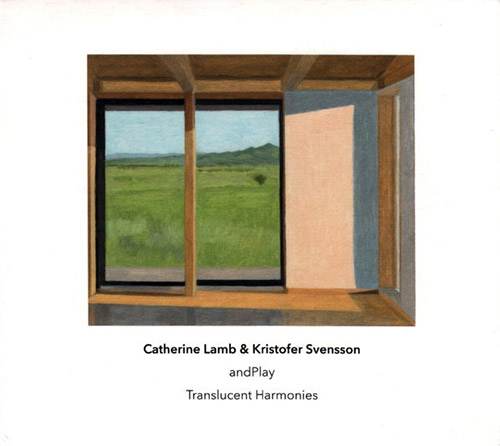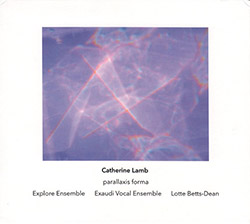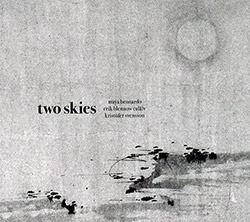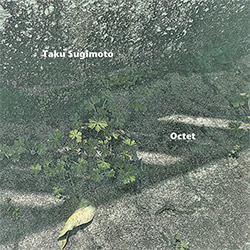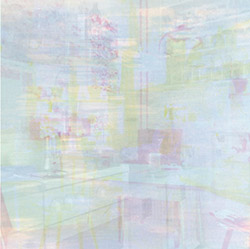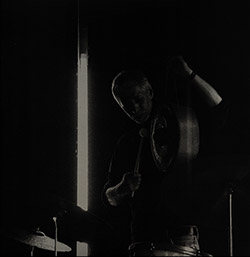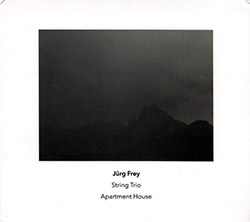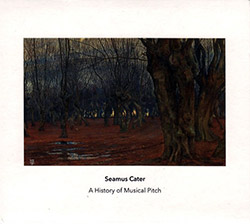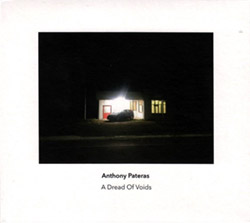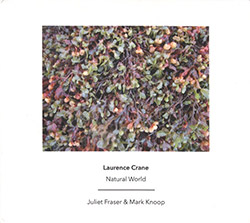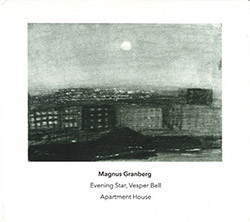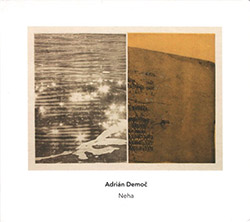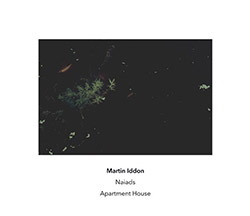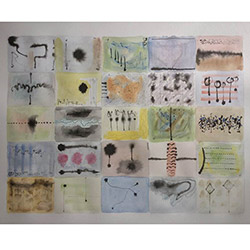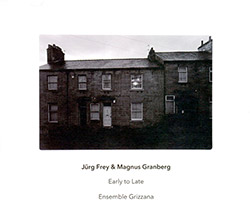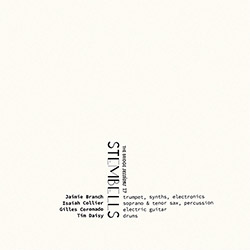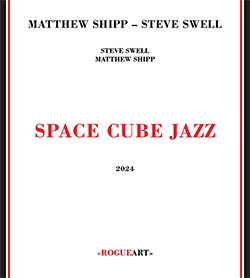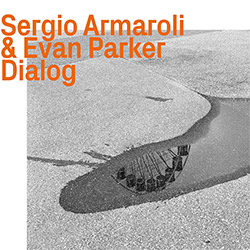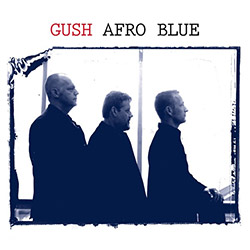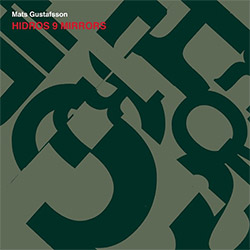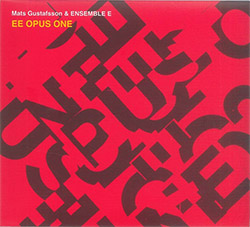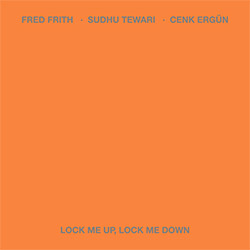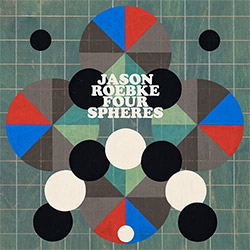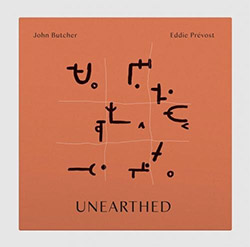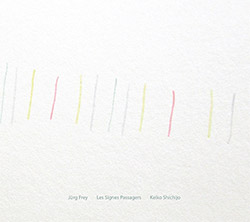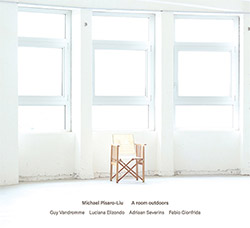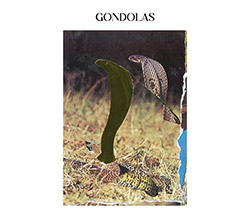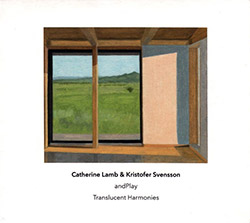
The New York-based andPlay duo of violinist Maya Bennardo and violist Hannah Levinson perform two extended works commissioned for their performance series, Translucent Harmonies: first an acoustic rendering of Catherine Lamb's "Prisma Interius VIII (Melodic Duo)"; then Kristofer Svensson's work of contrasts, surprises, modulations, and transformations.
In Stock
Quantity in Basket: None
Log In to use our Wish List
Shipping Weight: 2.00 units
Sample The Album:
Catherine Lamb-composer
Kristofer Svensson-composer
Maya Bennardo-violin
Hannah Levinson-viola
Click an artist name above to see in-stock items for that artist.
Label: Another Timbre
Catalog ID: at218
Squidco Product Code: 34095
Format: CD
Condition: New
Released: 2023
Country: UK
Packaging: Cardboard Gatefold
Recorded at Shiny Things Studio, in Brooklyn, New York, in March, 2022, by Mike Tierney.
"In Catherine Lamb's Prisma Interius series the unpredictability of the outside articulates the field of perception through precise bandpass filters, while acoustic instruments and musicians guide the unfolding of its harmonic space. A series of nine pieces exploring the potential of the Secondary Rainbow synthesizer, an instrument developed in 2016-2017 with Bryan Eubanks, that uses the live environment outside the performance space as a noise generator for basic subtractive synthesis. The intention is to dynamically fuse the outside world and acoustic instruments and what emerges is a sort of Aeolian harp residue highlighting the spectral information the listener might perceive in a given moment. A beautiful addition to an already impressive catalog of recordings and scores by the young composer."-Catherine Lamb website
Another Timbre Interview with Interview with Kristofer Svensson:
I guess a lot of people won't have heard of you, so could you tell us a bit about yourself and your musical background?
I am a composer and musician living in Sollentuna - a northern district of greater Stockholm. I write both fully notated compositions for classical/new-music musicians as well as open scores for improvising musicians. An example of the former is found on this album with andPlay - the occasion for this conversation. An example of the latter is the recording of the score "Av hav" that can be found on last year's album "two skies" with Maya Bennardo, Erik Blennow Calälv, and myself; the more open/improvisatory pieces are typically performed in settings in which I play the kacapi. I also have a handful of compositions that exist in between these poles of fully notated and improvised music.
In terms of my musical training, I have a background of practicing shakuhachi performance in the kinko-ryū school, studying jazz and Western classical music as a young bass player in Stockholm, learning the guqin in the Rong Family Tradition with Hammond Yung in Hong Kong, and studying Sundanese karawitan (primarily gamelan and tembang sunda cianjuran) in West Java with Dody Satya Ekagustiman and Ade Suparman. I love all of these traditions and had formative experiences from the periods I was immersed in each of them, but I do not identify as coming from or belonging to any one tradition more than any other. My primary interest was always to try to bring about experiences that I hadn't had with sound before, which is why I eventually turned to developing my composition and improvisation practice.
What about 'Vid stenmuren blir tanken blomma' - your long piece on the Translucent Harmonies album? How did that come about, and what does the title mean? Also, I understand that it uses Just Intonation, which, to be honest, I'd never have guessed as - to my layperson's ears - it doesn't sound like other JI pieces. Do all or most of your more notated compositions use JI, and if so, why?
The piece was commissioned by andPlay and they premiered it in 2018 as part of their concert-length program Translucent Harmonies which also included the duo version of Catherine Lamb's Prisma Interius VIII - as on the CD.
The piece's title roughly translates as 'By the stone wall, thoughts become flower'. I suppose that the function of the title is quite conventional: it uses words to help attune the listener to the non-verbal world of the piece. What is very unusual for me with this title is the word 'become' which implies transformation and change, but is something that I think is essential to what I wanted to explore. In this piece, there are many sudden non-expressive contrasts, surprises, modulations, and transformations. For me, the image of thoughts, or mind, becoming flower points to what I experience to be - for lack of better words - the religious nature of these juxtapositions: they enable a dynamic encounter with the ground of awareness from which different sounds are enacted - a sudden insight into the nonduality of mind and matter, experience and experiencer.
All my compositions - save for very few exceptions - use JI, and my improvisatory practice is also in JI. The question of why this piece in particular doesn't "sound" like other JI music can be answered in a couple of ways. The first answer has simply to do with the fact that this piece is in 5-limit JI. You're probably familiar with the idea that prime numbers greatly influence the sound of JI. While the primes 7, 11, and 13 generate interval sizes that sound different from Western European music, 5 (and 3 which it encompasses) generate interval sizes that, in their simplest form, do not sound radically 'unusual' to a musician trained in Western European music. My hope and belief, however, is that you would have said the exact same thing even of my pieces that are in 7, 11, and 13-limit JI. I typically, even in 13-limit pieces, work with simple intervals and do not generally explore the more thorny, 'microtonal' sounds that can be generated with JI. I work modally -building scales and modes by combining different simple ratios - rather than chromatically or microtonally. I then express these modes through rather strict contrapuntal constraints in order to ensure an idiomatic balance between directly and indirectly tunable intervals - i.e. to ensure performability - which for the listeners creates a situation where the intonation stays in the background: what I am interested in is the attunemental flavour of musical modes and the affective qualia of pitches as they are perfumed by the mode, not drawing attention to the intonation or microtonal profiles of pitches. Lastly, many composers are more interested in exploring the intervals generated by 7-limit and higher, so most "JI-composer's" music does not have the sound of 5-limit JI. This generalization also applies to my own practice as most of my works are in 11-limit or higher.
That's interesting. Some JI compositions don't really work for me as they sound like mathematical exercises, whereas your piece has a playfulness and unpredictability which I find very engaging. Did Maya and Hannah from andPlay find it relatively easy to take on your piece, or did its 'surprising' elements create problems for them? And how did you meet the duo?
While the piece is written to be light, unpredictable, and playful, this playfulness is situated in a quite placid scenery. There is a calmness and quietness that the playfulness arises out of and returns to. You are right that it is exactly the addition of playfulness, not the placidity, that makes it a challenging piece. In terms of ensuring a good performance out of a score, I have experienced with performances of my music that it is much less of a risk to write a piece that is solely calm and serene. The intricate rhythms, swift tempo changes, surprising turns, and pointillistic phrases of this score can only be brought to a state of playful lightness and buoyancy by dedicated performers who work closely together to carefully sculpt each phrase and tone-relating them to both local musical energies as well as the entire form of the piece. After first meeting Maya at a festival in the U.S. in 2015 where a piece of mine was being performed, I was asked to write a short piece for andPlay, so I knew from working with them that Maya and Hannah are excellent chamber music performers and incredibly synchronized and attuned to each other. It is because of their qualities that I was inspired to write this kind of challenging work. It is not an easy piece, but I knew they would enjoy the process required and that it would capture andPlay's strengths.
Going back to your first answer, could you say a bit more about your more improvisatory / open pieces? What is a kapaci, and why do you use it in improvisatory contexts?
The kacapi is as central to the traditional music of West Java as the piano is to European Classical music, so it was an instrument I learned as part of the process of studying Sundanese music. Because of its zither form with twenty easily retunable strings over four octaves, the kacapi also became a helpful tool for exploring new tunings and compositional ideas. Many of my compositions, such as Så vill jag glömma for solo violin and Som morgonånga betraktad for bass koto grew out of working at the kacapi. I soon found that I did not need to solidify this practice into fully notated compositions but that it was stimulating enough to improvise rather freely in these new kacapi tunings. I started inviting musicians to improvise in these tunings with me, and I have since found it to be a very rich way of creating music relationally. These improvisatory pieces spell out the JI mode in use and the different tunable paths one can take through it. In that regard, I bring the same care for tunability and contrapuntal constraints that characterize my written compositions to the improvised music-but treated more freely. Some scores give more directions than others-such as characteristic phrases and motives, depending on the tunings involved.
I confess that yours was a new name to me when this project was submitted, but I've since bought the 'two skies' album that you mentioned above, and am keen to hear more. What other music of yours is available, and what are you currently working on?
There are two quite recent releases by fantastic musicians that I especially would love for new listeners to discover. The first is Miyami McQueen-Tokita and Takashi Sugawa's recording of my short bass koto and cello duo 'Av dag och fattigdom', which appeared on Miyama's 2020 album 'Sonobe' on Namboku Records. Their performance of this brief, austere piece is very moving to me. The second is Mats Persson's beautiful recording of my half-hour-long clavichord piece 'I Sommarluft', released on the 2022 album 'Stilla sväva' on kuyin. Mats has been an essential part of the scene for new music in Sweden since the 1970's - being a real champion for strands other than mainstream modernism and minimalism - and he was the first musician to support and perform my music. Writing this piece for him, and collaborating on it, was a real highlight of recent years.
I'm currently working on a few different chamber pieces. In particular I've been spending a lot of time working at the spinet harpsichord recently. A big piece for 13-limit tuned keyboard, 'Som regn', that I worked on for many years just premiered at the Sixth Edition Festival for Other Music in Stockholm, and now I'm developing some new tunings for the instrument - among other things completing a long duo for harpsichord and violin. I'm also spending a lot of time with the kacapi this fall; improvising with friends and also working on a long solo piece called 'Kacapiblomster', which I'm going to perform a few times this fall in Sweden, Germany and Indonesia. I hope to record it sometime in the upcoming years as the follow-up to my 2020 kacapi solo album 'Andra Segel'."
Artist Biographies
• Show Bio for Catherine Lamb "Following interacting points within expanding harmonic space, Catherine Lamb has devoted her structural work to the inner life of tonality, constantly searching through the limits of human perceptions and resonances in overlaying atmospheres. Lamb's continued series Prisma Interius (2016-ongoing), made with her partner and frequent collaborator Bryan Eubanks, filters the outside environment into a harmonic field, basso continuo, tanpura, or bridge between the musical form and the perceptual listening space. Her first orchestral work, Portions Transparent/Opaque (2014), was premiered by the BBC Scottish Symphony Orchestra at the 2014 Tectonics Festival in Glasgow, Scotland. After an extended tour of her solo work Shade/Gradient (2012) through North America in 2012, Lamb received a travel grant from the Henry Cowell Foundation, allowing her to pursue work with Eliane Radigue and to form new relationships with European musicians.Earlier in her career, Lamb studied under composers James Tenney and Michael Pisaro at the California Institute of the Arts, where she also met director and dhrupadi Mani Kaul. It was during this time that she began diving deeply into her own practice of what she later termed "the interaction of tone." Lamb is the co-founder of Singing by Numbers (2009-11), an experimental vocal ensemble formed with Laura Steenberge that focused on pedagogical research around pure ratio tuning. She has written for ensembles such as Ensemble Dedalus, Konzert Minimal, the London Contemporary Orchestra, NeoN, Plus/Minus, and Yarn/Wire. Lamb is involved in ongoing research with Marc Sabat on intonation; with Johnny Chang on Viola Torros; develops work regularly with musicians such as Rebecca Lane, Dafne Vincente-Sandova, and Frank Reinecke; as well as taking part in Triangulum with Julia Holter and Laura Steenberge. Lamb is the recipient of a fellowship from Akademie Schloss Solitude (2016); an Emerging Composers Grant from the Wallace Alexander Gerbode and William and Flora Hewlett Foundations (2008-09); and was a Staubach Fellow at the International Summer Course for New Music in Darmstadt, Germany (2016). Lamb's writings and recordings have been published by another timbre, Black Pollen Press, Kunst Musik, NEOS, THE OPEN SPACE Magazine, Q-O2, sacred realism, and winds measure recordings.She received a B.M. from California Institute of the Arts, and an M.F.A. in music/sound from Bard College." ^ Hide Bio for Catherine Lamb • Show Bio for Kristofer Svensson "Kristofer Svensson (they/them) is a Swedish kacapi musician, music theorist, and composer whose music is characterized by simple moments of harmonic sounds appearing and disappearing in a dynamic correspondence with emptiness. Tuning harmony in Just Intonation, a characteristic feature of all their music, and often letting tones emerge from silence through noise, draws attention to music's simple raw materials-the aperture of sound and transparency of tone. Svensson's music have been performed by soloists and groups such as Contemporaneous, ensemble mise-en, Quatuor Bozzini, andPlay, Mats Persson & Kristine Scholz, Musica Vitae, Miyama McQueen-Tokita, the Swedish Wind Ensemble, N/A ensemble, Arcus Collective, Bennardo/Larson duo, Norbotten NEO, and the Hong Kong New Music Ensemble at festivals such as Bang on a Can Summer Music Festival (US, 2015), Kalv (SE, 2015), Nordic Music Days (FO, 2021), KROCH fest (SE, 2018), Svensk Musikvår (SE, 2019), Sound of Stockholm (SE, 2016), Ung Nordisk Musik (IS, 2017 and SE, 2019), University of Toledo's Festival of New Music (US, 2018), and o/modernt (SE, 2013). In October 2017, a portrait concert with Svensson's music titled "pale air (oscillating)" was given at Scandinavia House in New York City. Svensson studied the shakuhachi with Gunnar Jinmei Linder in Stockholm, the qín with Yung-Hak Chi in Hong Kong, and Sundanese karawitan (with a special emphasis on the kacapi) with, amongst others, Ade Suparman and Dody Satya Ekagustdiman, in West Java. These studies were supported by grants from the Indonesian Ministry for Arts and Culture (2013) and the Swedish foundations Gålös (2015), Anna Withlock Memorial Foundation (2014), AAA (2013 and 2015), and Erik och Göran Ennerfelts stiftelse (2015). Svensson studied composition with Fujieda Mamoru in Fukuoka, Japan supported by a JASSO Scholarship from the Japanese government (2015). Taken together, these musical traditions and lineages form the societal as well as spiritual context for Svensson's work-a context in which artistic, contemplative, and meditative practices merge. At the heart of Svensson's work lies a search for a resolution to the inescapable tension that lies between a commitment to the Buddhist path and a commitment to art. Svensson shares reflections from this search in the form of texts on soteriological aesthetics online at Intimating Emptiness. As a kacapi musician, Svensson has been developing a practice of justly tuned, modal, improvisation as both a solo performer as well as in collaboration with Maya Bennardo, Vilhelm Bromander, Ryan Packard, and Erik Blennow Calälv. In 2020, Svensson's debut solo kacapi album 'Andra Segel' was released on the kuyin label, and in 2022, a trio album with Bennardo and Blennow Calälv was released on the thanatosis label. Svensson's activities as a composer-performer have been supported by numerous grants from Swedish foundations and institutions such as Helge Ax:son Johnson Foundation (2014 and 2015), Anders Sandrews Foundation (2013), five awards from the Swedish Performing Rights Society (STIM, 2013, 2015, 2017, 2019, 2020), two awards from the Society of Swedish Composers (FST, 2016 and 2018) and a commission through the Swedish Arts Council to write the program stilla sväva, consisting of two pieces for early keyboard instruments, for Mats Persson and Kristine Scholz. Stilla sväva was premiered in 2019 and released on the kuyin label in 2022. Svensson obtained their Bachelor's degree in Music Composition from the Royal College of Music in Stockholm, where they studied composition primarily with Pär Lindgren but also with Magnus Granberg, and a Master's degree in Music Composition from the University of Hong Kong with the thesis "The Use of Just Intonation in my Recent Compositions". Expanding upon Lou Harrison's simple idea of a 'strict' and 'free' style of Just Intonation and correlating this idea with findings from recent research in music cognition and learning theory, Svensson formulated an expanded taxonomy of Just Intonation in which the novel 'loose style' of Just Intonation is articulated for the first time. This research can be found in the continuously updated online text Varieties of Just Intonation." ^ Hide Bio for Kristofer Svensson • Show Bio for Maya Bennardo "Maya Bennardo (she/her) is an active performer, improviser, and composer living between Brooklyn, NY and Stockholm, Sweden. Maya is interested in opening the dialogue and blurring the boundaries between composers and performers, and is devoted to performing music of the present. She is a founding member of the violin/viola duo andPlay, described by I Care If You Listen as "enthusiastic champions for new music and collaboration." She is a core member of Mivos Quartet and also performs new and traditional repertoire for violin and piano with pianist Karl Larson. Maya also performs regularly with Nouveau Classical Project and Hotel Elefant, and has worked with ensemble mise-en, Contemporaneous, Mimesis Ensemble, Ensemble Signal, [Switch~ Ensemble], and Talea Ensemble. Recent highlights include recording residencies at Electronic Media and Performing Arts Center (EMPAC) in Troy, NY and at the Elektronmusikstudion (EMS) in Stockholm, Sweden with andPlay, performances at the Library of Congress on the "Betts" Stradivarius violin (Washington D.C.), Walt Disney Hall on Noon to Midnight (Los Angeles, CA), Lucerne Festival Academy with Saul Williams (Lucerne, CH), North Sea Jazz Festival with Ambrose Akinmusire (Rotterdam, NE), June in Buffalo (Buffalo, NY), Lincoln Center Festival (NYC), and Strings of Autumn (Prague, CZ). Maya was a fellow at the Bang on a Can Summer Festival at Mass MoCa 2014/15, a member of the Lucerne Festival Academy Orchestra in 2014, and a participant in the Darmstadt Internationale Ferienkurse für Neue Musik 2016. Maya recently recorded her first solo record, 'four strings' with music by Eva-Maria Houben and Kristofer Svensson which will be released on the kuyin label, September 17th 2022. The album is a continuation of Bennardo's work exploring sonic fragility and temporal stasis on the violin. Maya enjoys a rich teaching life, and teaches students in her private studio. She graduated from NYU with a Master of Music and the Oberlin Conservatory of Music with a Bachelor of Music studying with Gregory Fulkerson at both institutions." ^ Hide Bio for Maya Bennardo • Show Bio for Hannah Levinson "Violist Hannah Levinson is an in-demand performer of contemporary and classical music based in New York City. She has recently been featured as a soloist and chamber musician at Carnegie Hall, The Stone, 92Y, Miller Theater, Willamette Valley Chamber Music Festival, June in Buffalo, and the Andy Warhol Museum, and at international festivals including the Kroch Festival (Stockholm), Musikprotokol Festival (Graz), Projektgruppe Neue Musik (Bremen), and Festival Musica (Strasbourg). Dedicated to working with living composers, Hannah has commissioned and premiered over 40 chamber and solo works and is currently editing the solo viola works of Lucia Ronchetti. Hannah is a founding member and Executive Director of the violin/viola duo andPlay, described by I Care If You Listen as "enthusiastic champions for new music and collaboration." andPlay's debut album, playlist (New Focus Recordings) was recorded as part of a residency at Renssaelaer Polytechnical Institute's Experimental Media and Performing Arts Center (EMPAC) and was included on "The Best of Bandcamp Contemporary Classical: October 2019" list. Committed to both contemporary and classical repertoire, Hannah is also a member of the Talea Ensemble ("a crucial part of the New York cultural ecosphere" New York Times), Fair Trade Trio, and the Albany Symphony Orchestra, and a former member of the Pittsburgh Opera Orchestra. She frequently performs with NYC ensembles including the International Contemporary Ensemble, either/or, counter)induction, Heartbeat Opera, Cantata Profana, Contemporaneous, and The Rhythm Method Quartet. A strong believer in sharing her artistic practice with her local community, Hannah is committed to audience engagement events through "andPlay (in) conversation," a free series in Upper Manhattan that provides opportunities for audiences to look inside the collaborative process of creating music, and through performances with organizations including "Music for Autism." Hannah is currently Music Artist Faculty at NYU Steinhardt and at the Manhattan School of Music Precollege. She earned her degrees at Oberlin College and Conservatory (BM in Viola Performance, BA in Russian East European Studies), Manhattan School of Music (MM in Contemporary Performance), and NYU Steinhardt (PhD in Performance). Her primary teachers include Karen Ritscher, Martha Strongin Katz, and Nadia Sirota. Her research explores how interactions between composers and political structures affect the creation of new music." ^ Hide Bio for Hannah Levinson
4/24/2024
Have a better biography or biography source? Please Contact Us so that we can update this biography.
4/24/2024
Have a better biography or biography source? Please Contact Us so that we can update this biography.
4/24/2024
Have a better biography or biography source? Please Contact Us so that we can update this biography.
4/24/2024
Have a better biography or biography source? Please Contact Us so that we can update this biography.
Track Listing:
1. Catherine Lamb: Prisma Interius VIII (Melodic Duo) 22:48
2. Kristofer Svensson: Vid Stenmuren Blir Tanken Blomma 40:14
Compositional Forms
Stringed Instruments
Duo Recordings
NY Downtown & Metropolitan Jazz/Improv
European Improvisation, Composition and Experimental Forms
New in Compositional Music
Search for other titles on the label:
Another Timbre.


